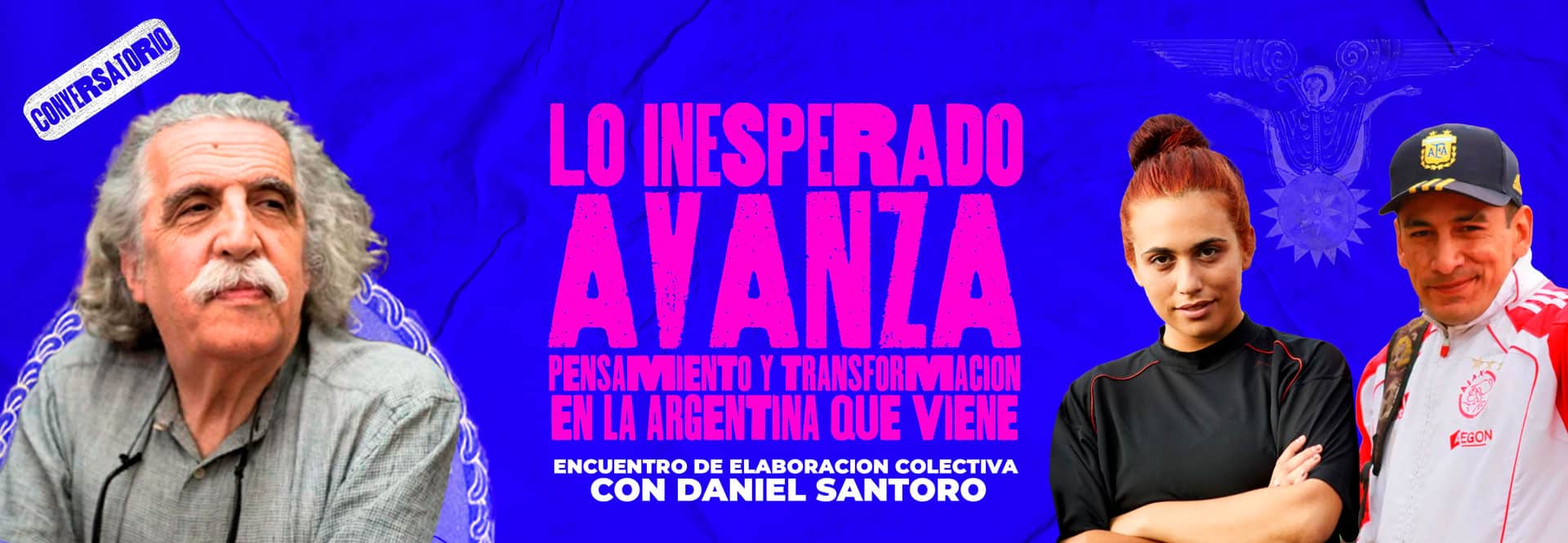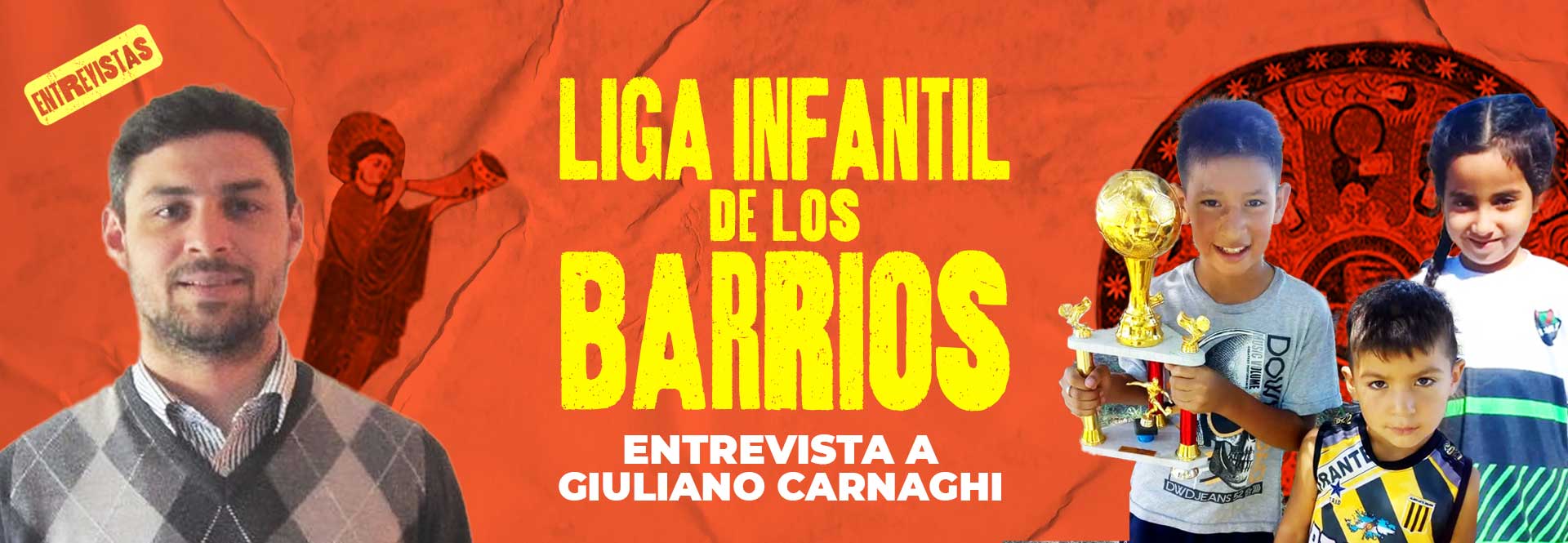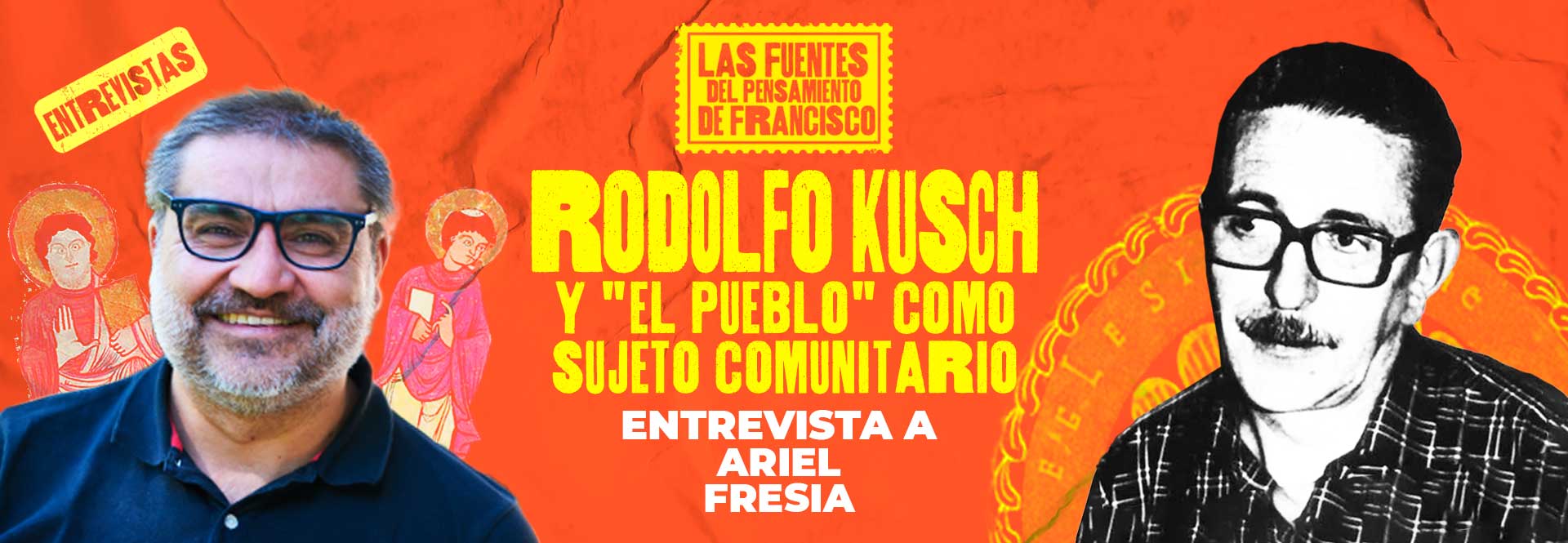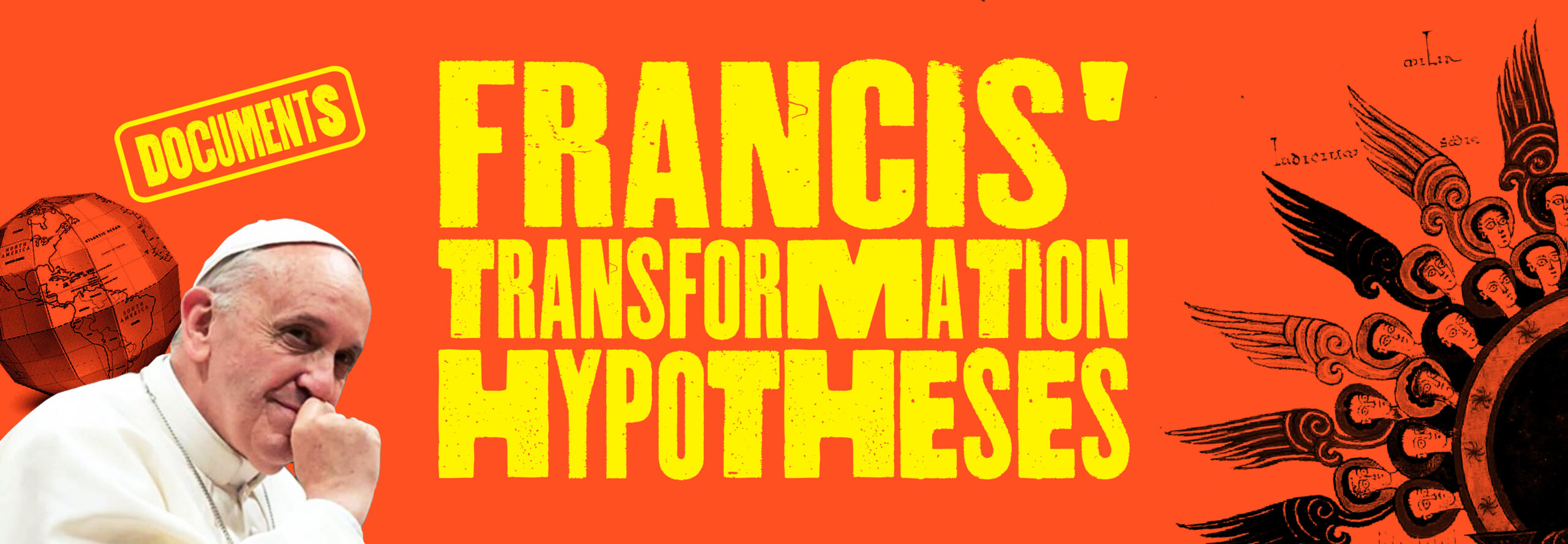
FRANCIS' TRANSFORMATION HYPOTHESES
Néstor Borri – Santiago Barassi
We go through the reflections of the Training Center at the End of the World (TCEW) in the spirit of proposing coordinates and elements that allow us to nourish the renewal and joy of shared thought and action. In the TCEW, we articulate four axes that intersect in a plot: the anomalous periphery as a place and starting point ( taking our own country, as a source and site, and at the same time as a reference for other peripheries), the thought of Francis ( universal, but also forged in concrete history, expressed today in a wide scene), the hypotheses of transformation ( which that circulates, fails, which are missing, which come, dialogue, which we seek) and the interventions and spaces of joint action, one of whose particular cases is the international cooperation / development projects, as an example of what it implies to intervene, to articulate, to propose and to compose in our concrete scene. The theories of social change, like the great revolutionary narratives of the 20th century, show their limits. The same occurs with the promisess of unlimited development and unidimensional evolution. Progress no longer fully orders the horizon and the modalities of change, even though innovation is presented as a central topic of contemporary society. The erudite voices, theories, indications and policies of international organizations appear only as stammers to mark out directions, to point out how and where to advance. Meanwhile, in the spaces that consider themselves progressive – note the paradox of the term – there are multiple searches to anchor and think about transformations. At the same time thoseexplorations are made around particular identities and subjectivity, fragmentation also multiplies and a sometimes euphoric disenchantment crosses narratives and methods. In any case, it is a complex but promissory moment that has its own challenges. We understand that these challenges are often located in the same place as its blockages. But in order to unlock them, we need an incitement to unsettle the current view and propose new questions, a provocation. Thus we take here Francis’ proposals, for they offer keys and clues to face this time of a forced restarting. With concrete images, proposals that cannot be captured by binary logic as well as poetry that overflows the expert discourses, “the Pope of the global south” introduces a novelty that we shouldn´t forget In the following twelve sections, we present the what we consider it´s the hypotheses of the transformation proposed by The Argentinan, Latin american Pope from the South. We are so sure that it is necessary to move forward from the mere citation of authority and repetition of Francis’ already famous formulas, to try out ways of connecting with what is more practical and audacious in them, as well as to question its limits and shortcomings, which of course it has. There may be some moments in which we have opted for an affirmative tone that can be understood as oversimplified, but we do it always with the intention of questioning and redolent provocation. Francis does not offer finished recipes or quick clarifications, he proposes and provokes, calling for involvement. Where he makes us uncomfortable or moves us, it is worthwhile to continue thinking and acting. The twelve points we share are thought with this same tone and that same gesture.
*These points are accompanied by twelve short podcasts that have the simple objective of inviting further conversations, and are in continuity and in the background of our own conversation and meeting around these issues. In this spirit and with the desire to continue weaving, we also share them at:
1. SPHERE / POLYHEDRON
“ Here our model is not the sphere, which is no greater than its parts, where every point is equidistant from the centre, and there are no differences between them. Instead, it is the polyhedron, which reflects the convergence of all its parts, each of which preserves its distinctiveness. Pastoral and political activity alike seek to gather in this polyhedron the best of each. There is a place for the poor and their culture, their aspirations and their potential. Even people who can be considered dubious on account of their errors have something to offer which must not be overlooked. It is the convergence of peoples who, within the universal order, maintain their own individuality; it is the sum total of persons within a society which pursues the common good, which truly has a place for everyone.”
Evangelli Gaudium, 236
Figures and geometry play an important role in Francis’ thought. They are part of his pedagogy and his ways. By proposing alternative images, another “geometry”, the Pope figures different metaphors that can order the image of the world and the field of the social.
To the sphere as a perfect, Platonic, abstract and ideal figure, Francis opposes the polyhedron. The sphere is the metaphor that orders globalization and, more broadly, totality. It is a figure of the closed, of the impossibility of novelty, and in this sense, it is also a metaphor for the end of history. The polyhedron, irregular and at some point ungraspable, preserves the edges, the irregularity, the unpredictability of the real. The polyhedron, if viewed from another plane, is an anti-Puritanian approach (purity = perfection).
In that sense, the polyhedron is even a figure that responds more to “the real” than to reality. The invitation of the figure is to encounter the roughness, the conflicts, the textures, the passions, the differences, with the raw and naked conflict, but also with the potential and richness of differences and even incompatibilities.
The sphere belongs to the field of “perfect” figures. The polyhedron, to the realm of the suboptimal, the non-ideal.
This connects directly with Francico´s critical thinking. We can say that there is an ideology of and in the sphere. It is true that to point to the “ideological” as partial or biased could be questionable on the understanding that it is impossible to access a non-ideological place. But what we are dealing with is the closure, the closure of forms.
It is not possible to access a metaphor or any figure that “directly” reflects or presents the reality in its complexity and with all of its conflict, there is always a mediation. And in that sense, there is always ideology and limited figures-geometries.
But, at the same time that he proposes the figure of the “polyhedron” as a more appropriate, more open alternative than the “sphere”, Francis points out the contact with the people, God or the Spirit or Love as points to stand ground in the face of the risks of ideological closure. (It is not by chance, categories difficult to be processed by the techno-bureaucratic paradigm that orients the globalization-closure-“spheronization” of the world, of the view, of history and of life).
The figure of the polyhedron incorporates and defends the complexity and singularity of each people and each actor or subject, and more concretely of “each one” in each situation, which is always an encounter.
In a broader perspective, the very edges, the elements of “imperfection” and even discomfort of the polyhedron are directly connected with the open possibilities of history and with the ever-renewed irruption of the capacity of each one to make a gesture of recommencement.

2. DIALECTICS / POLARITIES
“Solidarity, in its deepest and most challenging sense, thus becomes a way of making history in a life setting where conflicts, tensions and oppositions can achieve a diversified and life-giving unity. This is not to opt for a kind of syncretism, or for the absorption of one into the other, but rather for a resolution which takes place on a higher plane and preserves what is valid and useful on both sides.”
Evangelii Gaudium, 228
Faced with the dialectical understanding of reality and historical processes, with the question of opposites and overcoming syntheses (but also stable and finalistic, at some point), Francis proposes a tense coexistence between poles. It is a question of “non-dialectical polarities”.
This matrix can be traced in the thought of Romano Guardini, who proposes polar tensions as categories of understanding. This is expressed in many aspects of Francis’ thought, in his sayings and writings, in his practice and in his overall strategy. It is a practical approach, with a realistic spirit in the sense that it is an “operative” way of seeing. A way of operating. Action and decision-oriented.
The four principles for the construction of a people that appear in Evangelii Gaudium are the most emblematic and consolidated example of this perspective of polarities. In their encompassing content and in their formulation.
Time is superior to space; Unity prevails over conflict; Reality is more important than the idea; The whole is superior to the parts. These four categorical pairs, while establishing a prevalence or hierarchy and not a mere symmetry or correspondence, point above all to a way of maintaining the two poles in question. They pose a dynamic that needs both poles in relation.
It is interesting to keep in mind that the source of these principles, a singular piece of the Pope’s magisterium, is a concrete text from a founding and convulsive moment of Argentine history in the 19th century. A letter with recommendations on how to intervene in a conflict that threatened the incipient territorial and national unity (it is a letter from Juan Manuel de Rosas to Facundo Quiroga, known as the Letter of the Hacienda de Figueroa). In other words, its source is historical, political and situated in a convulsive and problematic moment of constitution and organization of a society in the south of the world).
This logic of polar, non-dialectical understanding is, above all, a practical approach that constitutes a strategic criterion guiding action. Maintaining – and accepting – the polarity of tensions as a dynamic source is a way of understanding leadership and collective construction. It is a criterion of intervention as well as the matrix of formulation of what Francis proposes at the doctrinal level. At one point, they are criteria that go beyond the abstract or concrete, general or particular, to become practical and existential: lived and for life.

3. A PROBLEM TO BE SOLVED / A JOYFUL MYSTERY
“The world is more than a problem to be solved; it is a joyful mystery that we contemplate with jubilant praise.”
Laudato Si’, 12
The irruption of the Pope of the South happens at a time when the techno-bureaucratic paradigm shows its limits and exhaustion. It is interesting to see how his criticisms and proposals are directed more to the (technical-instrumental) paradigm even than to the (capitalist) system. Not because he does not criticize the latter, but because he goes beyond it, to what sustains the system.
In this sense, it is possible to notice how Francisco’s proposals are positioned and pivot on the different historical moments where modernity bifurcated. They refer – implicitly or explicitly – to the philosophical and also existential knots where the resulting modernity ended up trapped by a ferocious logic that led to the current situation in which it is hegemonically capitalist but, even more so, techno-bureaucratic.
It is a paradigm that today finds its limit and is expressed in the void of meaning, the environmental crisis, the unbridled financial capitalism, and the massive discarding of people and peoples at the level of structures and actors, individually and collectively, in politics and in the economy, and also subjectively, in the life of each one and in the great global processes.
In the figure of Francis of Assisi, the Pope finds one of those points of bifurcation from which he proposes a new beginning. Universal fraternity, joy and kindness, beauty, poverty as freedom from merchandise, are traits of the “madman of Assisi” that must be taken beyond folklore and put in a political key.
In the face of the mechanical and smooth figures of the functioning of the market, Francis recalls the power of the inefficiency of mercy in thinking beyond the techno-bureaucratic paradigm and its automatic response to any “problem”. This view contains a rest of mystery that proposes a background that cannot be captured by the inertia of the paradigm, which is reflected in an attitude of contemplation and joy that enables a different encounter with the world, history and life.

4. INTIMATE STRUCTURE / CARESSING CONFLICTS
“When conflicts are not resolved but kept hidden or buried in the past, silence can lead to complicity in grave misdeeds and sins. Authentic reconciliation does not flee from conflict, but is achieved in conflict, resolving it through dialogue and open, honest and patient negotiation”
Fratelli Tutti, 244
How to act in the face of concrete conflicts in institutions, relationships between individuals and groups, societies and individual and conflicting interests? Francis proposes to approach conflicts from the perspective of their “inner structure” in order to have a new starting point.
By saying “intimate structure” he shows that, as opposed to the obvious structure, the one that appears first in any confrontation or dilemma, it is always possible to go a step further and approach and understand an underlying, deeper structure, which is tasted, experienced and – also because of the way it affects – can be resolved at another paradigmatic level (of understanding, of the actors and of the link between them and with the issue involved).
This supposes a particular closeness in which all the senses play, A proxemics, Time and presence, a being, a time of being, a bodily presence. We can say, above all, that it supposes and is a clinic, which is nothing other than leaning to go over the most incarnated singularity of the situation.
“Caressing conflicts” implies a thought and criteria that are not abstract. The expression is not a metaphor (or rather, not just that).
It points towards concrete gestures, a real closeness and effective contact. In other words, it assumes and demands the way caresses happen: with heart involvement, touch and contact, skin and presence, delicacy and tenderness.
And it also supposes the personal decision to enter into a particular mode of relationship and connection. From there it is necessary to see the institutional and collective implications of this: how “caressing” takes shape when it involves actors that go beyond individual persons, but the starting point is always experiential and practical. Gestural in the sense that this is real.
That every collective, social or institutional conflict involves people in their corporeality, spirituality and possibilities – the relationship of their gestures with their decisions – is one of the central contents and criteria of this expression. Here empathy dialogues with strategy.

5. OVERCRANKING / OVERFLOW
“In no way does this mean relativizing problems, fleeing from them or letting things stay as they are. Authentic solutions are never found by dampening boldness, shirking concrete demands or assigning blame to others. On the contrary, solutions are found by “overflow”, that is, by transcending the contraposition that limits our vision and recognizing a greater gift that God is offering. From that new gift, accepted with boldness and generosity, from that unexpected gift which awakens a new and greater creativity, there will pour forth as from an overflowing fountain the answers that contraposition did not allow us to see.”
Querida Amazonia, 105
Contact with the periphery and the frontier, as well as with one’s own personal and collective (institutional and conceptual) borders or limits, occupy a central place in Francisco’s hypotheses of transformation.
Edges, trench, skin, door, periphery, conurbation, etc. These images of the border imply contact and also involve movement, transfer, and presence in the place. In situ. This is the locus proposed by Francis. A place to go and, at the same time, a “from where” to be, to live, to experience, to look and to understand. It is also a point of (new) departure: from there it is necessary to step out again and walk.
What happens or can happen there is a transformation by overflow. In Francis, overflow refers to a superabundance that at the same time is a work, a search and also an encounter and a gift. Very concretely, a superabundance of the spirit and of love. That which changes the contours and redesigns the figure. That which crosses by force and by transfiguration what was previously a limit, a separation or an obstacle.
It is always something that happens in an intermediate zone, that is affected and allows itself to be affected by something that comes at the same time from within and from without.
The overflow is a hypothesis and a proposal about the logic in which discussions are settled, conflicts are overcome and taken up again. In the overflow, what in the dialectical schemes is counteracted or annulled as synthesis is received as a shared and overcoming gesture. By moving and sustaining themselves in time, the discordant or opposing elements ferment in some way, change in their intimate structure – almost like a chemical or even alchemical process – and then relate to each other in a different way. That is why changes do not usually appear as a rupture, but as a new assumption of conflicts in another scene.
In this sense, the overflow supposes the possibility, the consideration and above all the experience of a beyond “internal” to the situation itself. The beyond is a place, but also a position and above all a movement. In terms of peripheries – geographical, social and existential – the edge is a way of dealing with the perimeter, as a boundary and also as a place of passage. Standing on the border to generate an encounter.
The border separates, but also connects. And treating it differently allows for an overcoming: a beyond that, nevertheless, is preserved in the hereafter and embraces the richness of the parts. This is what is disconcerting about Francis’ thought: not only is it not dialectical, but it is not utopian, nor is it alternativist.
“Overcranking” and “overflow” are similar expressions, but for Francis one is negative and the other positive. “Overcranking” – a colloquial expression, and mechanical, too – refers to a speed and above all to a self-absorption, a loss of the notion of what is going on beyond oneself. It is an excess rather than an overabundance. “Overcranking” is a movement of one’s own idea, of oneself, of a part, which ends up turning the wrong way and ruining “the mechanism”.
Overflow, on the other hand, is above all the result of incorporation of voices and perspectives. The will to add heterogeneous and even contradictory elements force the limits within which a discussion, reflection or negotiation takes place. Differences and insurmountable limits do not disappear, but are incorporated by the appearance of a new perspective. Something like a new bowl that contains the ingredients in a different way and a different fire to heat them. Ultimately, a new substance, constructed with a particular form of the mixture.
But it is not about a “Habermasian” dialogue, nor is it about the mere willingness to understand each other. Not even a dialogue as the best of Latin American pedagogy might suggest. “Overflow” is the result of getting into the game and the scene in a different way. It is necessary to take risks. To provoke overflow through courage and audacity. And “endurance”: a form of persistence, permanence and also a bit of stubbornness.
Playing on the edge, but inside; inside, but on the edge: where what changes in the end is the very consistency of the inside and its relationship with the outside. This is the underlying meaning of “making noise”, an early phrase of Francis that has been quickly and easily trivialized. For it is not a matter of simply attracting attention with something different, but of making a difference that affects the structure of what is at stake.
Behind the overflow is simply the practical idea, the action and effect of the Spirit. The notion has theological and even Trinitarian support. The dynamic of the spirit – which is not for nothing “wind” and “breath” – manifests itself in two ways: with the subjective attitude of courage and with the objective call to go beyond. The result is a new scene of encounter with the crowd and the outside. Therefore, just as it is work, it is also a gift. And it has to do directly with love put into practice.

6. OUTPUT / SYNODALITY
“A Church which “goes forth” is a Church whose doors are open. Going out to others in order to reach the fringes of humanity does not mean rushing out aimlessly into the world. Often it is better simply to slow down, to put aside our eagerness in order to see and listen to others, to stop rushing from one thing to another and to remain with someone who has faltered along the way. At times we have to be like the father of the prodigal son, who always keeps his door open so that when the son returns, he can readily pass through it.”
Evangelii Gaudium, 46
For this reason, the culture of encounter proposed by Francis is not simple or “internal”, but has a profound requirement of openness and a condition of going out.
It is an encounter that requires a movement of decentering and a contact with the outside. Because “to go out” is at the same time “to bring in”, as well as the logic of meeting and generating a new inside.
In the same way that it supposes to leave the already traced routes, it implies not to get lost in any path – even if it is necessary to explore them – but to really build a new shared path.
That is why synodality is Francis’ matrix of institutional transformation. It is a commitment to incorporate actors and perspectives in order to build shared criteria that allow the reformulation of hypotheses and the renewal of forces.
It is not a matter of adding elements or characters to a static image, but of generating a shared time, a process, through which a virtuous exchange is generated, but above all an understanding of the other: a fraternity based on reciprocal mercy.
This type of process is effective, but does not conform to the usual forms of efficiency. Mercy is by definition inefficient: this is the origin of a more effective fraternity. Because it assumes the real, in its suboptimal dimension.
It is a proposal of realistic humanity and historicity as raw as it is transfigured by contemplation and courage.

7. INCOMPLETE THINKING / PERSISTENT AND COURAGEOUS DIALOGUE
Unlike disagreement and conflict, persistent and courageous dialogue does not make headlines, but quietly helps the world to live much better than we imagine.
Fratelli Tutti, 198
At the point where reality is more important than the idea, something of the raw real grows that challenges each category and the moment in which these close upon themselves as ideology. That is why Francis’ proposal invites us to opt for open categories, and to explore the situation with them. This is how he operates and builds. With a certain degree of provisionality and with a non-eliminable component of ambiguity (which may bother some and challenge and disconcert many).
This is why Francis often needs – and likes – to invent words. Something typical of all those who have explored or tried to put on stage and available to many a search of their own, an experience and an intuition. Something that is invented along the way of doing and discerning.
This translates into a form of thought that is incomplete by style and by choice. As a proposal, even as a virtue of those that are difficult to sustain. It contains a certain degree of imprecision that may generate anxieties to those who position themselves from other visions. But above all from other expectations and interests, or urgencies.
The proposal, demanding as a bet and that supposes a particular availability, is this: what at the beginning is lost in clarity, is gained as a new condition of possibilities for articulation and action.
Thought is open because it is situated. And being situated, it can open itself without decomposing itself. So it is not postmodern relativism. It is comprehensive and (because of this) incomplete. Open and local. It is universal by projection.
It is a thought situated not only in epistemological or cultural terms, but also in relation to disputes of interests and ways of understanding the concrete happiness of each people and, most especially, by a particular position and disposition in the face of suffering and pain.
This openness, if it is not to be mere diplomacy, or if it is not to result in the rituals of politeness or the gestures of complacent beneficence, demands a “persistent and courageous” dialogue. Persistent, so that it is not interrupted at the first hint of conflict. Courageous, so that it is not captured by the myth of “communicative action” and the rational resolution of conflicts of interest.
It is a mode of thought linked to passion: it is suffered, it requires patience, it involves passion.
Thus, incomplete thinking is connected like a wheel with both the character and texture of dialogue, with the directions of shared action that are tried out and, in the end, with a different understanding of the common collective: the community.

8. DISCERNMENT - DOCTRINE – DISCIPLINE
It never closes itself off, never retreats into its own security, never opts for rigidity and defensiveness. It realizes that it has to grow in its own understanding of the Gospel and in discerning the paths of the Spirit, and so it always does what good it can, even if in the process, its shoes get soiled by the mud of the street.
Evangelii Gaudium, 45
Doctrine might appear at first glance as the proper field of a Pope’s thought, and the level at which his ideas about transformations are expressed.
But Francis’ hypotheses of transformation are embedded in his emphasis on discernment, and are translated into a discipline of action. That is why it impacts on a particular understanding of doctrine.
The force of gestures, the act of presence, the courage of contact – touching wounds, which are connected to intimate structures – and the exercise of dialogue somehow mature in a different scene where the impossible becomes inevitable. The doctrine somehow outlines or indicates what is possible and what is permitted, but discernment and discipline transform these coordinates, and somehow the doctrine itself.
In the same way that the shape of the sphere is changed to that of the polyhedron, in each concrete scene the edges acquire another character. This is not a magic trick or voluntarism, but a discipline and a criterion on how to move forward and how to wait.
Again: it requires passion, in its triple meaning. Of patience, of suffering and of passion. It requires letting oneself be affected.
Discernment is very characteristic of Jesuit spirituality. It entails a strong placement in the situation and in each case. It is not a direct application, but a consideration of the singularity that questions general norms and abstract ideas. It starts the thought in a situation, in a space, and besides that it takes its own time. It applies in and to the present. It responds to what is presented, and at the same time it does not allow itself to be carried away by the speed of what with its own force or with its particular inertia asks for immediacy or speed. It has its own rhythm. It is an urgent but leisurely ruminant. It takes a distance in order to really be.
As well as it is located and “soaked” in time, it connects in a special way with the interiority. With a plane that has to do with prayer and spirituality, and also with personal responsibility. It connects inside and outside.
So, it questions, but at the same time it “fulfils” the doctrinal plane, and at the same time it takes shape in discipline: in task and action. Transforming because it sustains a decision.

9. DEPARTURE, PERIPHERIES AND ENCOUNTER
“ The Church which “goes forth” is a community of missionary disciples who take the first step, who are involved and supportive, who bear fruit and rejoice.”
Evangelii Gaudium, 24
The basic movement proposed by Francis is to “to go forth“.
Along with that there is a direct reference to the peripheries.
The culture of encounter is a framework that encompasses both.
Going out, “to go forth” is a pastoral and missionary movement, but at the same time it is a way of ecclesiology. A dynamic of construction of the collective and the institutional.
The peripheries, on the other hand, are marked in plural and with three dimensions: geographical, social and existential peripheries. In other words: places, poverty and exclusion, and personal and collective biographies and lives.
The culture of encounter is therefore a culture of contact and learning, which results above all from the gesture of going out to the peripheries.
For this reason, although it refers to harmony, it contains a demand on and from discomfort and conflict. Because it is not an encounter without cost – even if it is free – but an encounter oriented in one direction and conditioned in the sense that it implies a distance from the initial place, from the institutional and security frameworks.
Defining from where it is necessary to go out, orienting oneself to the peripheries and generating and living a type of encounter that derives from this, is a “combo” that gives new meaning to these three topics. It is not a matter of going without going out, it is not a matter of going anywhere and it is not a matter of meeting the predictable-equals.

10. NON-UTOPIAN TRANSFORMATIONS
“Such an economy is not only desirable and necessary, but also possible. It is no utopia or chimera. It is an extremely realistic prospect. We can achieve it. The available resources in our world, the fruit of the intergenerational labors of peoples and the gifts of creation, more than suffice for the integral development of “each man and the whole man””
SECOND WORLD MEETING OF POPULAR MOVEMENTS, Bolivia
Francis’ hypotheses of transformation are not related to utopia. Beyond what may seem to us at first glance, his logic does not propose “another possible world”. If we confront or compare them with the proposals of altermondialism – which is the view that leads us to interpret his thought in that key – we will find things in common but we must also recognize strong differences.
Francis is not an alternativist. He does not propose reforms that can be defined rapidly or in the usual sense as radical, progressive or total. For many he may seem lukewarm. Or even conservative.
It is neither convenient nor fruitful to think of the Argentine Pope in the classic left-right opposition nor in the progressive-conservative one, usual in the analysis of theological or pastoral positions. Those are not the axes that order his thought. For three reasons: because these pairs of opposition do not correspond as polarities, but exclude each other, on the one hand. On the other hand, because in any case the Pope’s thought is more ordered by the “up-down” axis and not so much by the left-right axis. And finally, because of the empirical fact that he does not think, express or propose these categories.
Returning to the non-utopian theme: they are transformations that prefer to be concrete rather than total or totally “other”. That is why they are not “elsewhere”, but are embodied here. They are here and now, and not later. Not beyond: neither in space nor in time. They contain a proposal that alters, but they are not absolute alternatives that are presented to the subjects as a totally different proposal to the reality that is lived.
They opt for the real and the possible, without possibilism, but at the same time with the haste -corporal, in the temporality of human suffering- to concretize. That is why they have more strongly the imprint of gesture and initiative than that of the alternative project. And it counts much more on the concretion of the action with all its limits or errors or insufficiencies, than on the “alternative”, perfect or radical projects.
In this same line, and precisely for this reason, it is a thought whose hypotheses of transformation are much more political than ideological.

11. POLITICAL SAMARITANISM: THE GESTURE OF THE RECOMMENCEMENT
“We can start from below and, case by case, act at the most concrete and local levels, and then expand to the farthest reaches of our countries and our world, with the same care and concern that the Samaritan showed for each of the wounded man’s injuries.”
Fratelli Tutti, 78
In Fratelli Tutti, Francis offers a complete and comprehensive look at the current situation and its limits. There you can see a panorama of how he sees the situations and what he proposes as a central factor. Brotherhood in its universal dimension, fraternity and social friendship.
In the same way that this is the panorama, and these are the vectors, Fratelli Tutti contains one more contribution to understand its hypothesis of transformation. At the heart of this writing, the parable of the Good Samaritan brings much of the paradigm and the “basic unit”(TN :the term can be used to refer to a political party club or local), the fundamental module t0hat Francis proposes to transform.
The parable is inserted in the encyclical in such a way that it can be seen how it fits into a more general look, and on the other hand it is explained and broken down, interpreted and put “in pedagogy” to be assumed practically.
The Samaritan is the one who makes the concrete gesture, getting out of the way, and bending over the fallen and, with strength, lifting him up. The other actors are also presented as figures. It is not minor that those who know (about religion or law) somehow fail (“pass by”) in the story. Nor is it minor that it is pointed out in the encyclical that we are all, to a certain extent, all of the characters (including also the victim and the thieves). Here we have an idea of how Francis understands who is or who can be the subject of transformation: we all have a bit of each character, and we can all assume the role of “Samaritans” as well.
The gesture is central. It constitutes a practice, has consequences and generates a new encounter. A new beginning. The gesture is a new beginning, beyond systems of ideas, laws, religion itself, and beyond the path initially taken.
“Samaritanism” is a name for personal, intimate, responsible practice, and it is also a form of politics. The dimension and dynamics of political samaritanism is what constitutes the heart of the proposed policy. That is why in the encyclical the chapter that speaks of “an open heart” is directly connected to that of “the best politics”.
And in this way – this is central to Francis – it is possible to begin again. Opening, with gesture and encounter, another time. Right here, right now. Articulating the personal and the collective.
.

12. PEOPLE
“There is a thinker you should read: Rodolfo Kusch, a German who lived in northwestern Argentina, an excellent philosopher and anthropologist. He made one thing clear: that the word ‘people’ is not a logical word. It is a mythical word. You cannot speak of a people in a logical way, because it would only be a description. To understand a people, to understand what the values of that people are, it is necessary to enter into the spirit, the heart, the work, the history and the myth of their tradition. This point is truly at the basis of the theology called ‘of the people’. It means to go with the people, to see how they express themselves. This distinction is important. The people is not a logical category, it is a mythical category”.
Francis in “Politique et societé”, 2017
Gunter Rodolfo Kusch, an Argentine anthropologist of German origin whom Francis constantly refers to, points out that all thought “needs a constant”.
That constant in Francis’ thought is the category of people. And the people themselves.
The people, the reference to “people” is the guarantee that the transformation is not tied to the “liquid” vertigo of modernity or to empty or imposed ideas of innovation. At the same time, it is what allows it to flow through a channel, with its own dynamics and flow, with its current and its strength. And also to overflow.
In his documents and allocutions, the Pope alternately mentions the “holy faithful people of God”, the faithful people, the poor, the people as such and the peoples. All these denominations are intertwined with each other, with degrees of redundancy and ambiguity, of connection and concatenation that, precisely, flow in Francis’ thought and proposals.
The edges that seem diffuse in terminology are the possible zones of overflow – we could also say of articulation – in practice. It is an ambiguity at the same time inevitable and sought after. Of matrix of origin and of strategy.
In practice: which is in pastoral care, if by pastoral care we mean not only the properly pastoral action in the religious sense but also the modes of responsibility in the insertion in and with the people, with the collective or the institutions (for example, the Church) but also any other institution that entails or mediates a responsibility of leadership.
People, in Francis’ theology, in its conceptual understanding, has to do with the theology of the people, which precisely emphasizes these aspects. In the framework of the great current of Latin American theology, the theology of the people is inserted – but we can also say that it is in tension – with the theology of liberation. As a clue to go deeper, it is possible to explore in what way “people” interrogates or conditions that generic name of transformation that is contained in “liberation”.
There are two ways to approach this: one, to understand that, in Francis, “people” is “more important” – it overdetermines – “liberation”. It is a possibility that, if one thinks about it, opens up questions and possibilities, dynamics and horizons, and therefore different conditioning factors, about what “liberation” actually is. This is not precluded, but justly held to be, as one sees at first glance, what may designate each of the terms of that different character. The other way of incorporating this tension is this, which fits more directly with the Pope’s proposals: the priority and centrality of the people indicate above all that any process (liberation, transformation, project, emancipation, etc.), must be “not-without-the-people”. Or in other words: “not without the people”.
And it goes further. Francis affirms again and again that “people is not a logical category but a mythical category”. This does not refer linearly to the people as a myth, but being the people something very concrete, relational, corporal and situated, the category functions with a different logic, which is precisely not logical but “mythical”. In other words, it has the capacity to gather and animate, to propose figures and criteria that transcend and go beyond mere “logic” (technical, power, organizational, significant and even social, political or even ecclesial).
The understanding of “people” as a reality and as a category, as a place and as a myth, comes to Francis from his formative, existential, historical, pastoral, cultural and political experience. In particular, from the ways in which in Latin America, but especially and singularly in Argentina, popular life and the people as actors are experienced. The weight of the idea of the people in Argentine history, society and politics is the counterpart and the basis also of what the theology of the people gathers in the form of reflection and category.
That is also the reason for the multiple clarifications, points, even debates in which Francis intervenes to differentiate the European notion of “populism” from the social, cultural, political and also religious experience that constitutes the people in Argentina. The political sequence and the historical experience that in Argentina is called Peronism is inseparable from what Francis proposes. Not because Francis is necessarily “Peronist”, because that is not what it is about, but because, as we have been pointing out, we are before a thought situated both temporally, geographically and socially. It has vivid and lively roots; existential.
This thought with roots that is in Francis, must be understood from this flesh and blood, and it is enriched by approaching us to the existential historical reality of his land of origin.
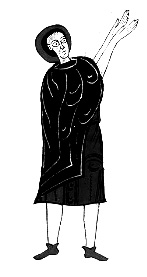
Thanks to Tomas Borri and @InglesParaTodos for the translation.
BIBLIOGRAPHY
- Francisco, Politics and Society: Conversations with Dominique Wolton
- Francisco, Encyclical Letter Fratelli Tutti, on fraternity and social friendship
- Francisco, Encyclical Letter Laudato Si ’, on the care of the Common Home
- Francis, Post Synodal Apostolic Exhortation, Dear Amazon
- Francis, Apostolic Exhortation Evangelii Gaudium, on the proclamation of the Gospel in today’s world
- Francisco, Speech at the II World Meeting of Popular Movements, Santa Cruz de la Sierra, Bolivia
- GUARDINI, Romano, The contrast. Essay of a philosophy of the living-concrete
Kusch, Rodolfo, Deep America
